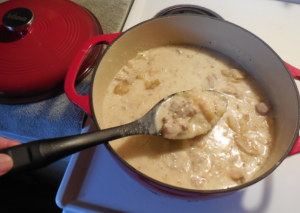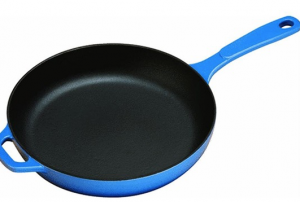This is the second of two articles on cast iron cookware.
Cast iron cookware has stood the test of time and remains very popular with Kentucky cooks who prepare traditional meals in the kitchen and around the campfire.
This includes grilling cuts of beef or venison, frying fish, chicken, squirrel or rabbit, and concocting meat and vegetable stews, roasts, soups, and chili. This versatile cookware can even be used to bake bread and cobbler desserts.

Porcelain enameled cast iron Dutch Overs are ideal for soups, such as this creamy German-style potato soup, made with bratwurst and sauerkraut. (Art Lander Jr. photo)
This cookware is created by a process in which glass is bonded at temperatures of 1200 to 1400 degreesF to cast iron cookware. The glaze of glass on the surface of the cast iron prevents rusting, eliminates the need of seasoning, allows thorough cleaning, and is a non-stick surface. With proper care this cookware will last for generations.
Porcelain enameled cast iron Dutch Ovens may be the most versatile because they are ideal for slow cooking at lower temperatures, which draws flavors from foods, in soups, stews and roasts.
Dutch Ovens were the model for the modern Crockpot slow cooker.
Dos and Don’ts of Porcelain Enameled Cast Iron Cookware
• Enameled cast iron is compatible with most all heat sources and stovetops. It can be used without worry on gas, electric, ceramic and induction cooktops. Most brands of this type of cookware are oven safe up to 500 degreesF. Consult the instruction book that came with your cookware.

• It may be used to marinate or store foods in the refrigerator, freeze entire prepared meals, and since it is colorful and aesthetically pleasing, it is often used to serve food.
• Enameled cast iron cookware should not be used in microwave ovens, on outdoor grills or campfires.
• Its surface can be damaged, can chip or crack, by sudden temperature changes. Allow cookware to cool down before washing. Skillets and covered dishes my chip if banged together or dropped.
• Cook on low to medium heat on the stove top since cast iron has superior heat retention and distribution.
• Avoid using metal kitchen utensils, such as spoons, forks or spatulas, as they can scratch or chip the finish.
• Washing by hand is recommended, with dish soap and a plastic scrubber. Never use abrasive cleaners.
• Porcelain enameled cast iron cookware is relatively expensive, generally costing about 35 percent more than regular cast iron cookware.

It will not rust. There is no exposed cast iron. (Lodge Manufacturing photo)
Lodge Manufacturing, of South Pittsburg, Tennessee, sells a line of porcelain enameled cookware, including Dutch Ovens, skillets, covered casserole dishes, square grill pans, and round and oval cocottes, small covered dishes in which individual portions of food can be cooked and served.
• Cookware is available in a rainbow of colors, including blue, red, green, orange, and purple.
• Lodge entered the marketplace in 1896 as Blacklock Foundry, and has been in business for over 120 years.
Porcelain enameled cast iron cookware costs more and demands a higher level of care, but is a decorative choice for special occasions at home, and is ideal for tailgating and deer camp when meals are prepared over LP gas cookers.
And this cookware makes a great birthday, wedding or holiday gift for friends and family who share your enjoyment of the culture of food.






















